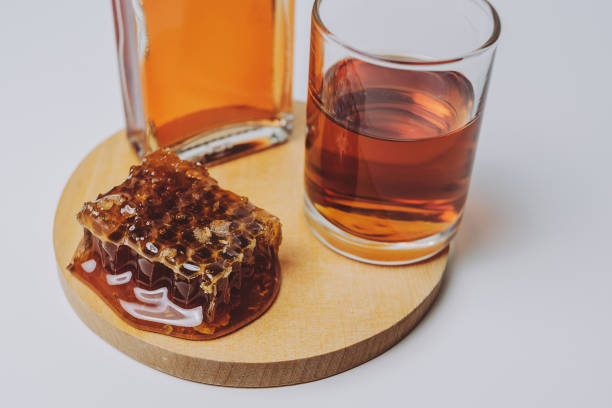Mead, often regarded as the beverage of history, is experiencing a resurgence among homebrewers and enthusiasts. This ancient drink, crafted from honey, water, and yeast, boasts a heritage dating back thousands of years. In this post, we will delve into the recipe for creating your own traditional mead.

Understanding the Fundamentals: Balancing Honey and Water
Crafting a mead heavily relies on striking the harmony between honey and water. The accepted ratio recommended by experts is one part honey to three parts water. However, true artistry in mead-making lies in experimenting with ratios. Trying a mead recipe 1 gallon is the best for experimentation.
Increasing the quantity of honey used in the recipe allows you to craft a more robust mead. Conversely, reducing the amount of honey results in a drier mead. Regular tastings throughout fermentation enable you to gauge how these adjustments impact the flavor profile.
Infusing Flavor: Exploring Fruity Additions
While traditional mead originally features honey as its fermentable ingredient, incorporating fruits into the mix opens up new horizons. This infusion introduces variations that enhance complexity and flavor profiles.
Popular fruit additions include raspberries, blackberries, cherries, peaches, and oranges. You can add these fruits directly to the fermentation vessel or, during fermentation for different outcomes. It’s about experimenting and finding the fruit combinations that create a mix of flavors.
Enhancing Aromatics: Yeast Selection
Choosing the yeast is crucial in mead-making as it greatly influences the aroma and taste of each batch. Mead enthusiasts commonly use different yeast strains to bring out characteristics.
For example, if you want a profile with floral notes, champagne yeast is a good choice. On the other hand, ale yeasts produce fruity esters that enhance sweetness in meads. Trying out yeast strains allows you to customize your product according to your preferences.
Patience is Key: Fermentation and Aging
Once you’ve combined honey, water, fruit, and yeast in your fermentation vessel, it’s important to create an environment for these ingredients to work their magic. Store your mead in a dark place with temperatures between 60 to 70 degrees Fahrenheit.
Fermentation can take anywhere from a few days to weeks, depending on factors like temperature and yeast viability. It’s essential to be patient during this stage as it allows the flavors to fully develop.
Once the primary fermentation is complete, it’s beneficial to transfer the mead to a container for fermentation. This step helps clarify the liquid by separating any sediment or fruit solids, resulting in a texture and an elegant appearance.
Furthermore, allowing the mead to age brings about improvements as flavors mellow and become more harmonious over time. Experienced mead makers often recommend aging for six months, but certain styles can benefit from longer aging periods of a year or even more.
Bottling Your Masterpiece: Carbonation Options
When it comes to deciding whether or not to carbonate your mead, it ultimately boils down to preference. Carbonation adds liveliness and effervescence that some find refreshing, while others prefer the still characteristics.
For those who enjoy carbonation, there are two methods: bottle conditioning and forced carbonation. Bottle conditioning involves adding an amount of priming sugar before bottling, which leads to carbonation through continued fermentation inside each bottle. On the other hand, forced carbonation speeds up this process by using kegs and CO2.
Sharing the Joy: Delicious Mead Pairings
Now that your homemade mead has aged gracefully and either carbonated beautifully or remained still, it’s time for enjoyment! Similar to wine, mead pairs wonderfully with a variety of foods. Here are some delicious pairing suggestions;
1. Cheese Pairings: Consider trying a mead alongside some cheddar or indulge in the combination of a fruity mead with brie.
2. Grilled Meat Complements: The rich flavors of grilled lamb or pork roast beautifully harmonize with a sweet mead.
3. Balancing Spicy Dishes: To tame the heat in dishes like curry or Mexican cuisine, opt for a mead to achieve that perfect balance.
4. Indulging in Chocolate Desserts: Treat yourself to pairing a decadent and sweet mead bottle with chocolate truffles or cake.
Conclusion
Let’s raise our glasses and toast to the art of crafting old-school mead! Creating your batch allows you to connect with centuries of brewing techniques while showcasing your creativity and personal taste. By considering ratios, fruit additions, yeast selection, patience during fermentation and aging, carbonation options, and food pairings, you can craft an old-school mead that truly reflects your passion for this timeless beverage. So gather your ingredients and embark on this journey as honey transforms into gold within your glass!
Hey welcome to my blog . I am a modern women who love to share any tips on lifestyle, health, travel. Hope you join me in this journey!

Speak Your Mind